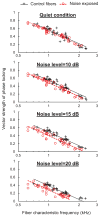Effects of sensorineural hearing loss on temporal coding of narrowband and broadband signals in the auditory periphery
- PMID: 23376018
- PMCID: PMC3688697
- DOI: 10.1016/j.heares.2013.01.014
Effects of sensorineural hearing loss on temporal coding of narrowband and broadband signals in the auditory periphery
Abstract
People with sensorineural hearing loss have substantial difficulty understanding speech under degraded listening conditions. Behavioral studies suggest that this difficulty may be caused by changes in auditory processing of the rapidly-varying temporal fine structure (TFS) of acoustic signals. In this paper, we review the presently known effects of sensorineural hearing loss on processing of TFS and slower envelope modulations in the peripheral auditory system of mammals. Cochlear damage has relatively subtle effects on phase locking by auditory-nerve fibers to the temporal structure of narrowband signals under quiet conditions. In background noise, however, sensorineural loss does substantially reduce phase locking to the TFS of pure-tone stimuli. For auditory processing of broadband stimuli, sensorineural hearing loss has been shown to severely alter the neural representation of temporal information along the tonotopic axis of the cochlea. Notably, auditory-nerve fibers innervating the high-frequency part of the cochlea grow increasingly responsive to low-frequency TFS information and less responsive to temporal information near their characteristic frequency (CF). Cochlear damage also increases the correlation of the response to TFS across fibers of varying CF, decreases the traveling-wave delay between TFS responses of fibers with different CFs, and can increase the range of temporal modulation frequencies encoded in the periphery for broadband sounds. Weaker neural coding of temporal structure in background noise and degraded coding of broadband signals along the tonotopic axis of the cochlea are expected to contribute considerably to speech perception problems in people with sensorineural hearing loss. This article is part of a Special Issue entitled "Annual Reviews 2013".
Keywords: AN; CF; ENV; FM; SPL; SR; TFS; auditory nerve; characteristic frequency; envelope; frequency modulation; sound pressure level; spontaneous rate; temporal fine structure.
Copyright © 2013 Elsevier B.V. All rights reserved.
Figures






Similar articles
-
Distorted Tonotopic Coding of Temporal Envelope and Fine Structure with Noise-Induced Hearing Loss.J Neurosci. 2016 Feb 17;36(7):2227-37. doi: 10.1523/JNEUROSCI.3944-15.2016. J Neurosci. 2016. PMID: 26888932 Free PMC article.
-
Temporal modulation transfer functions measured from auditory-nerve responses following sensorineural hearing loss.Hear Res. 2012 Apr;286(1-2):64-75. doi: 10.1016/j.heares.2012.02.004. Epub 2012 Feb 16. Hear Res. 2012. PMID: 22366500 Free PMC article.
-
Effects of sensorineural hearing loss on temporal coding of harmonic and inharmonic tone complexes in the auditory nerve.Adv Exp Med Biol. 2013;787:109-18. doi: 10.1007/978-1-4614-1590-9_13. Adv Exp Med Biol. 2013. PMID: 23716215 Free PMC article.
-
Effects of hearing loss and age on the binaural processing of temporal envelope and temporal fine structure information.Hear Res. 2021 Mar 15;402:107991. doi: 10.1016/j.heares.2020.107991. Epub 2020 May 11. Hear Res. 2021. PMID: 32418682 Review.
-
Supra-Threshold Hearing and Fluctuation Profiles: Implications for Sensorineural and Hidden Hearing Loss.J Assoc Res Otolaryngol. 2018 Aug;19(4):331-352. doi: 10.1007/s10162-018-0669-5. Epub 2018 May 9. J Assoc Res Otolaryngol. 2018. PMID: 29744729 Free PMC article. Review.
Cited by
-
Selecting auditory alerting stimuli for eagles on the basis of auditory evoked potentials.Conserv Physiol. 2022 Sep 16;10(1):coac059. doi: 10.1093/conphys/coac059. eCollection 2022. Conserv Physiol. 2022. PMID: 36134144 Free PMC article.
-
Factors Affecting Sentence-in-Noise Recognition for Normal Hearing Listeners and Listeners with Hearing Loss.J Audiol Otol. 2017 Jul;21(2):81-87. doi: 10.7874/jao.2017.21.2.81. Epub 2017 Jul 5. J Audiol Otol. 2017. PMID: 28704894 Free PMC article.
-
Distorted Tonotopic Coding of Temporal Envelope and Fine Structure with Noise-Induced Hearing Loss.J Neurosci. 2016 Feb 17;36(7):2227-37. doi: 10.1523/JNEUROSCI.3944-15.2016. J Neurosci. 2016. PMID: 26888932 Free PMC article.
-
Psychophysical and modeling approaches towards determining the cochlear phase response based on interaural time differences.J Acoust Soc Am. 2017 Jun;141(6):4314. doi: 10.1121/1.4984031. J Acoust Soc Am. 2017. PMID: 28618834 Free PMC article.
-
Noise-induced hearing loss increases the temporal precision of complex envelope coding by auditory-nerve fibers.Front Syst Neurosci. 2014 Feb 17;8:20. doi: 10.3389/fnsys.2014.00020. eCollection 2014. Front Syst Neurosci. 2014. PMID: 24596545 Free PMC article.
References
-
- Abbas PJ. Auditory-nerve fiber responses to tones in a noise masker. Hear Res. 1981;5:69–80. - PubMed
-
- Ardoint M, Sheft S, Fleuriot P, Garnier S, Lorenzi C. Perception of temporal fine-structure cues in speech with minimal envelope cues for listeners with mild-to-moderate hearing loss. Int J Audiol. 2010;49:823–831. - PubMed
-
- Bacon SP, Gleitman RM. Modulation detection in subjects with relatively flat hearing losses. J Speech Hear Res. 1992;35:642–653. - PubMed
-
- Carney LH, Heinz MG, Evilsizer ME, Gilkey RH, Colburn HS. Auditory phase opponency: a temporal model for masked detection at low frequencies. Acust -Acta Acust. 2002;88:334–347.
Publication types
MeSH terms
Grants and funding
LinkOut - more resources
Full Text Sources
Other Literature Sources
Research Materials

